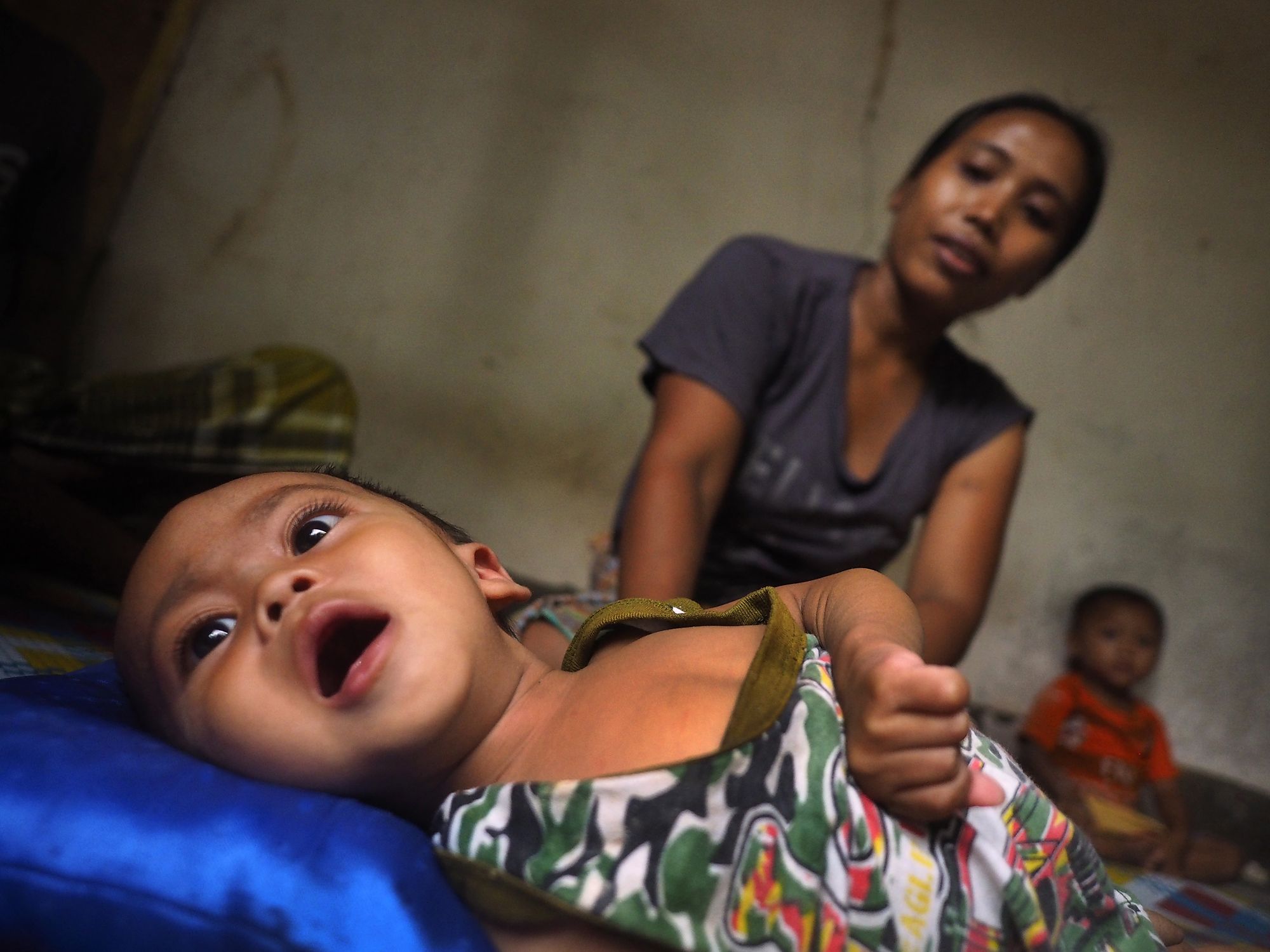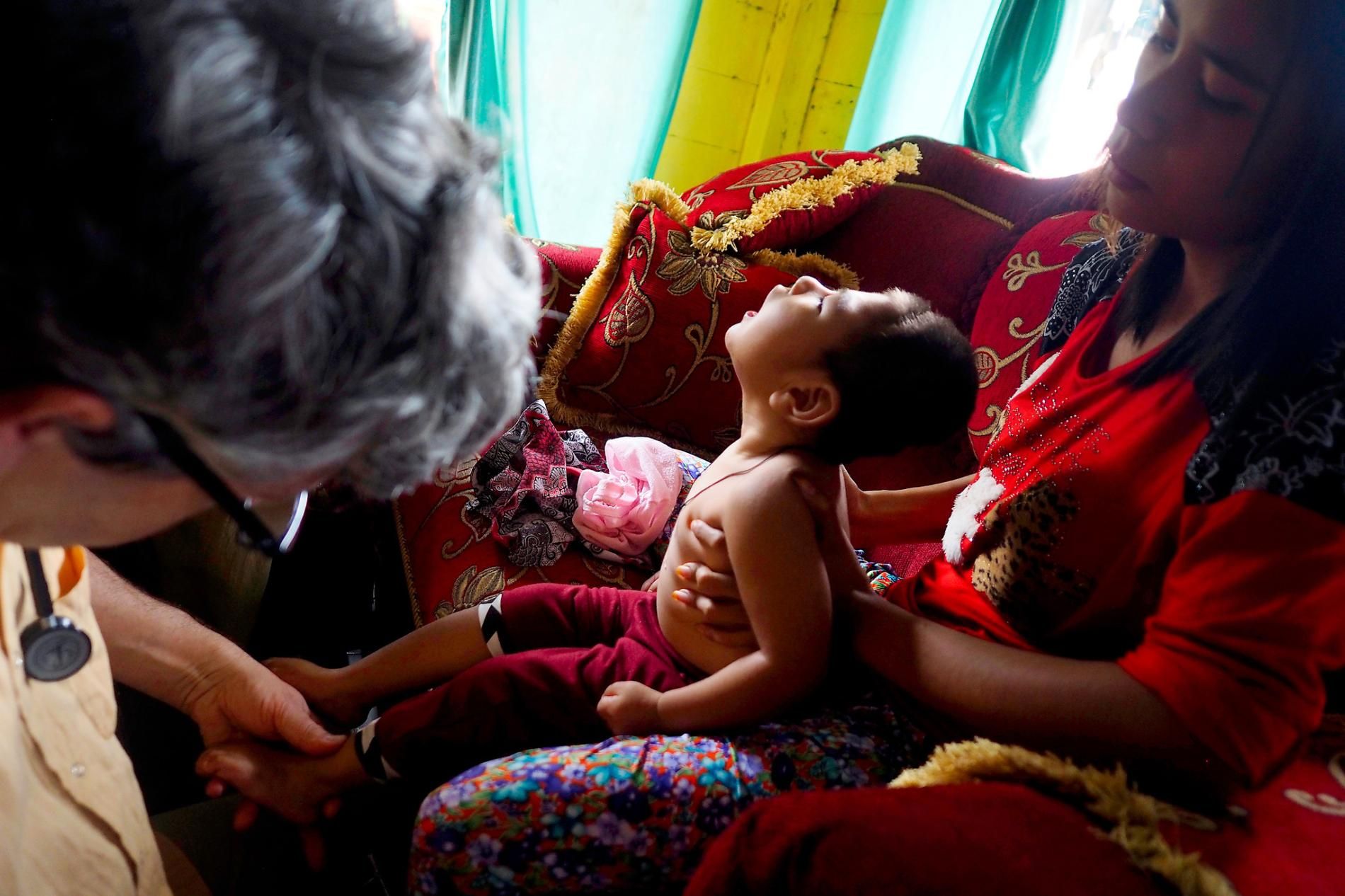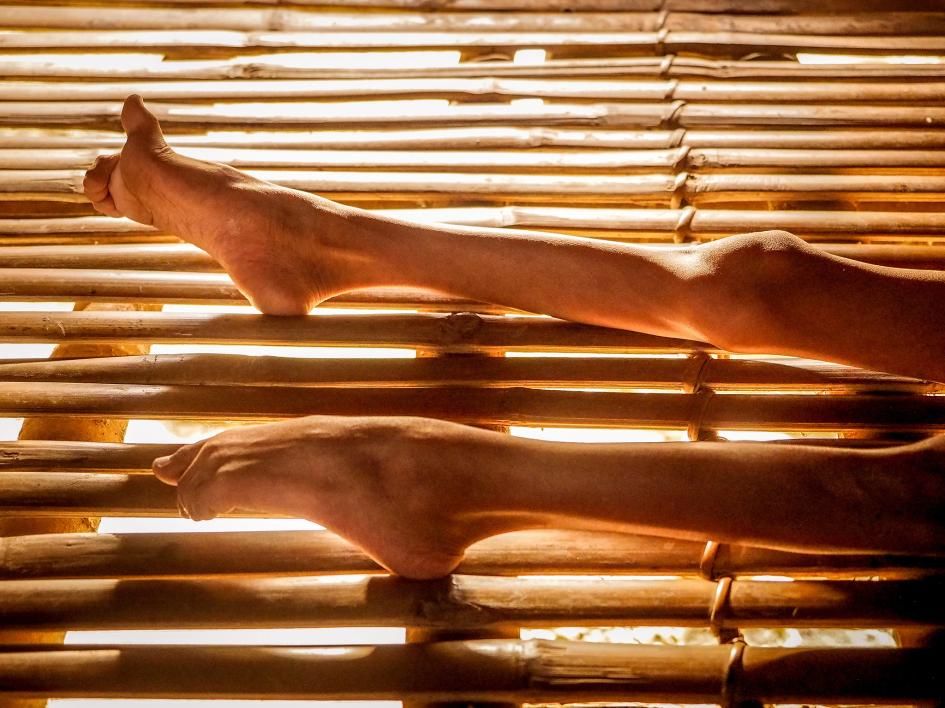JERENGJENG, Indonesia—Ipan is 16 months old and suffering his third seizure of the morning. His head is too large for his body and his legs are as thin as sticks. He arches his back, and his limbs stiffen. He cries out in pain.
His mother, Fatimah, tries to comfort Ipan but there’s not much she can do. A dukun, or shaman, says his soul was invaded by the spirit of the monkey, bat, and octopus. On his advice, Fatimah and her husband Nursah changed the boy's name from Iqbal to Ipan and fed him tiny rice balls mixed with octopus.
“The dukun says this is why Ipan’s legs look like a monkey’s legs,” Nursah says. “Actually, I don’t believe that, but I will try anything.”
Doctors say the real culprit is more down-to-Earth: mercury poisoning. His parents are gold miners who used the heavy metal to process gold for years before Ipan was born, including while Fatimah was pregnant.
Millions of people in 70 countries across Asia, Africa, and South America have been exposed to high levels of mercury as small-scale mining has proliferated over the past decade. The United Nations Environment Programme estimates that at least 10 million miners, including at least 4 million women and children, are working in small-scale or “artisanal” gold mines, which produce as much as 15 percent of the world’s gold.
In Indonesia, more than 1 million small-scale miners scratch out an illegal living digging for gold in at least 850 hotspots, says Yuyun Ismawati, a 2009 winner of the Goldman Environmental Prize who has conducted extensive research on illegal mining.
Ipan is one of at least 46 suspected victims of mercury poisoning in impoverished southwestern Lombok, a tourist island next to Bali. Doctors have found another 131 suspected victims in three other mining districts.
Some miners heat mercury in their kitchens, where the vapors can reach concentrations that are quadruple the amounts considered safe under World Health Organization standards.
High doses of mercury, which is a neurological poison, are a well-documented cause of birth defects, including crippling deformities and nervous system disorders. The most notorious episode of mercury poisoning occurred in Japan in the 1950s when a factory dumped the heavy metal into Minamata Bay. More than 2,000 people were poisoned by the bay’s seafood, leading to deaths as well as a generation of children suffering severe birth defects.
Mercury poisoning is “a serious health problem” in Indonesia, says Stephan Bose-O'Reilly, a pediatrician and environmental health expert at the University of Munich.
"Prenatally, methyl mercury can harm the fetus, resulting in Minamata disease with severe birth defects and developmental delays," he says.
Mining With Mercury
Small-scale gold mining began to take hold in Indonesia after the 1998 fall of Suharto, its longtime military ruler, and has flourished in an ensuing era of lax governance. Nearly all artisanal miners use mercury to extract gold even though the practice is banned by the government.
Indonesia, with the world’s fourth largest population spread across a vast archipelago of 17,500 islands, has among the highest incidence of illegal mercury use, says Bose-O'Reilly during a recent trip to Indonesia to examine mercury victims in the gold fields.
"Indonesia is a real global hotspot," he says. “I haven’t seen anything worse than here."
Indonesia’s small-scale miners produce $5 billion in gold a year, according to Atmadji Sumarkidjo, a special assistant to Coordinating Security Minister Luhut Pandjaitan. That is about 7% of the country's total gold production. By contrast, Indonesia's gross domestic product was about $888 billion in 2014.
Miners have released hundreds of tons of mercury into the water, soil and air, often in poor, remote areas, contaminating food and wildlife.
In the Central Java city of Wonogiri, where illegal gold miners have operated for more than 15 years, residents were alarmed two years ago when the local environmental agency tested guava, cassava, papaya and banana grown in the area and found them to be highly contaminated with mercury.
Doctors working with the environmental group BaliFokus Foundation, including Bose-O'Reilly, identified the 177 cases of suspected mercury poisoning on the islands of Java, Lombok and Sulawesi, says Ismawati, a co-founder of the group. The figure includes 57 children and 59 victims who have died since they were examined.
Ismawati calls it “a public health emergency.”
“Children in the mining areas have been exposed to mercury since they were in the womb and some are born with deformities,” she says. “When they grow up, they inhale contaminated air, drink contaminated water, and eat contaminated rice.”
Indonesia’s Gold Rush
In Indonesia, miners flock to newly discovered gold fields, often in national parks or on other public land, where they operate without legally required permits. They dig deep mine shafts, tear apart mountains, dredge rivers, destroy forests and poison the environment.
Noisy tumblers known as ball mills operate almost continually in mining communities, often next to homes, grinding the ore along with mercury and water to extract the gold. As the tumblers rattle and spin, the rock breaks down and flecks of gold bind to the mercury. Afterwards, the miners drain off the liquid and recover some excess mercury, but much of it becomes vapor and pollutes the air or flows onto the ground and into waterways.
In some villages, families use mercury-laced mine waste as the foundation for their homes or to surface their yards and walkways.
In the final stage of extracting the gold, the miners typically heat their mercury and gold with a blowtorch, sending poisonous mercury vapors into the air.
Child labor is common in the gold fields, with boys as young as 8 digging the ore and as young as 12 burning the mercury-gold amalgam.
Mujiburrahman, 14, who lives in the West Lombok village of Luang Baluk, says he began torching mercury two years ago. “I burn the amalgam two or three times a week,” he says. “I never wear protective clothing.”
The smoke, he says, simply “disappears.”
Doctors have identified 24 children in mining villages in the Sekotong district in southwestern West Lombok with birth defects or ailments caused by mercury.
Among them is Lailatul Azwa, who was born in September without a left hand. Like Ipan, she suffers frequent seizures.
Six-year-old Aida was born with deformed fingers on both hands.
Nyimas, who suffered from an enlarged skull and other serious deformities, died earlier this year at the age of 8. She was in a near-vegetative state all her life.
Gold miners use mercury in its elemental form, which is liquid at room temperature. Inhaling the vapors produced by burning the amalgam is the most dangerous exposure, doctors say.
“Mercury vapor is very toxic to the brain, especially during development, and exposures may therefore be detrimental to pregnant women and small children,” says Harvard environmental health professor Philippe Grandjean, a leading expert in the effects of mercury exposure.
Cooking Mercury
Karto Paimin, 67, lives with his family in the placid hills above Wonogiri in a wooden, Javanese-style house with a high peaked roof and a large living area. The family has tunneled about 50 feet into the hillside below the house to find ore, which they process with mercury in their ball mill in the garden.
After many hours of labor, Paimin has produced a small lump of mercury and gold, which he takes to the kitchen at the far end of the house. The room has a dirt floor, woven bamboo walls and a rudimentary wood stove with no chimney. Two large pots of soup simmer on the fire at mid-afternoon.
Paimin brings out a piece of pipe, which is about 18 inches long and closed at one end. He slips the mercury-gold amalgam into the sealed end of the pipe and places it in the fire. He rests the other end of the pipe in a small dish of water on the floor. His daughter, Yuni, 33, and grandson, Galang, 9, squat nearby to watch.
As the pipe heats up, the mercury melts and most of it flows into the dish. But some evaporates and the fumes escape into the room.
Krishna Zaki of the group BaliFokus has lugged a portable vapor analyzer into the kitchen and tests the air. He detects about 4,000 nanograms of mercury per cubic meter, four times the World Health Organization’s safety threshold of 1,000.
When the process is complete, Paimin retrieves a hot two-gram pellet of gold, which he can sell for the equivalent of about $75.
Outside, Paimin’s wife, Dinah, 55, has been complaining of headaches and difficulty breathing. Ismawati gives her simple coordination tests, including touching her nose with her finger and moving her wrists simultaneously. She does poorly and Ismawati recommends she get tested for mercury exposure. Dinah is shocked. She and her husband had no idea mercury was harmful.
“Now I know,” Paimin laments. “But before today I didn’t know and I cooked the mercury in the kitchen.”
"Like an Iceberg"
Since Roman times, when slaves worked the cinnabar mines, mercury has been known to cause a wide range of symptoms, including headaches, tremors, drooling, difficulty walking, and eventually death. But mercury poisoning can be difficult to diagnose because it has many symptoms in common with other ailments.
The extent of mercury-related health problems in Indonesia is only now emerging as BaliFokus, volunteer doctors, and a few government officials search out victims and test for mercury in the air, food, homes, and water.
Ismawati, who is spearheading the effort, says the discovery of more than 140 mercury victims is a sign that Indonesia faces one of the world’s worst mercury disasters.
She believes that many victims have died without ever being diagnosed and that many more suffer unnoticed in remote mining communities. The cases identified so far only scratch the surface, she says.
Grandjean agrees: “I’m sure that the number of poisonings is underestimated,” he says.
Erick Gunawan, a public health service doctor in Sekotong, has held two screenings in mining communities with BaliFokus’s help and found dozens of potential mercury victims. He believes there are many more who have been poisoned and hopes to hold more screenings.
“It’s like an iceberg,” he says. “You only see what’s on top but you can’t see what’s below.”
Claims of Extortion
The slow-growing environmental disaster has begun to attract attention from top officials in the administration of President Joko Widodo.
Pandjaitan, the Coordinating Security Minister, recently cited illegal mining as one of the security challenges facing the country. Sumarkidjo, his aide, says the minister was referring in part to the illegal miners who destroy the environment and spread mercury in their communities.
He says the minister was particularly concerned by the rapid destruction and widespread use of mercury by miners on remote Buru Island, the site of a former prison in the Maluku Islands where a gold rush has drawn many thousands of miners since 2012.
“It’s not small-scale when you look at Buru Island,” he says. “It will take years to clean up the mercury.”
Gatot Sugiharto, founder of the Indonesian People’s Mining Association, says miners are forced to give as much as half their earnings to corrupt police and soldiers who control access to mining areas and demand payment. He alleges that billions of dollars go into the pockets of officials who should be enforcing the law against using mercury.
“The miners lose about 50% of their product to pay the extortion,” he says. “Sometimes police take it all.”
Sumarkidjo agrees that the miners’ illegal status makes them vulnerable to extortion and acknowledged that the police and military take a significant share.
“Our office does not have proof of how much they take,” the minister’s aide says. “But you can’t do these illegal things without the understanding of the authorities – the police and the local military. Everyone takes the opportunity to take something.”
Sugiharto, a former miner, advocates legalizing the small-scale miners and argues it is the only way to end mercury use.
Operating outside the law means the miners pay no taxes, depriving the government of much-needed revenue. If they were legal, he says, the government could teach them to use non-mercury methods, regulate their activities, and collect taxes to pay for health care, mercury cleanup and land rehabilitation.
“Being illegal, all activity is uncontrolled,” he says. “They use mercury inside their houses, hiding from the public or from the officers. It’s very, very dangerous because sometimes they burn the mercury in the kitchen or in their rooms.”
Global Action
The extent of mercury contamination around the globe has prompted international action.
In 2013, 128 nations signed the Minamata Convention, named after the Japanese disaster, which aims to limit the trade and use of mercury worldwide.
The UN convention doesn't ban mercury in small-scale gold mining but requires the signatories to "take steps" to reduce its use and eliminate it "where feasible." Countries are required to draft detailed action plans for eliminating amalgam burning and educating the public on mercury's dangers, among other steps.
Indonesia signed the pact but is not among the 25 countries, including the United States, that have ratified it so far. It will take effect once 50 nations ratify it.
Tuti Hendrawati Mintarsih, director general of hazardous waste in Indonesia’s Ministry of Environment and Forestry, says her agency is developing the country's action plan. But in tackling the mercury problem, she says the government is hampered by overlapping jurisdictions and a lack of funds to locate victims, provide care and clean up contamination.
In the meantime, mining continues uninterrupted.
Resti Fauzia, 2, has never spoken a word. She stopped walking at 18 months, says her mother, Ocih. She can’t grasp objects or stand without help. When she sleeps, she has seizures.
Her family lives in the village of Pangkal Jaya near Pongkor Mountain, about 60 miles southwest of Jakarta. Illegal miners have been digging for gold there since at least 2000. More than 10,000 miners work there today.
For 15 years, Resti's family has operated a ball mill just outside the kitchen door. Volunteer doctors working with BaliFokus examined the girl and concluded she was suffering from mercury poisoning.
On the day the medical team examined her, mercury levels outside the kitchen measured 20 times higher than the WHO safety threshold.
“No one ever told us that mercury is dangerous,” Ocih says.







